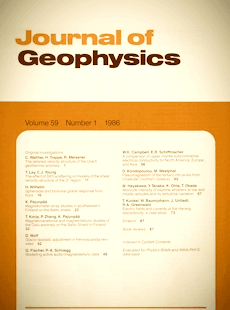A comparison of upper mantle subcontinental electrical conductivity for North America, Europe, and Asia
Article Sidebar

Vols. 1-18 (1924-1944), ISSN 0044-2801
Main Article Content
Abstract
Spherical harmonic analysis coefficients of the external and internal parts of the quiet-day geomagnetic field variations (Sq), separated for the North American, European, Central Asian and East Asian regions, were used to determine conductivity profiles to depths of about 600 km by the Schmucker equivalent-substitute conductor method. All three regions showed a roughly exponential increase of conductivity with depth. Distinct discontinuities seemed to be evident near 255-300 km and near 450-600 km. Regional differences in the conductivity profiles were shown by the functional fittings to the data. For depths less than about 275 km, the North American conductivities seemed to be significantly higher than the other regions. For depths greater than about 300 km, the East Asian conductivities were largest.
 ARK: https://n2t.net/ark:/88439/y028414
ARK: https://n2t.net/ark:/88439/y028414
Permalink: https://geophysicsjournal.com/article/232
Article Details
References
Banks, R.J. (1969) Geomagnetic variations and the electrical conductivity of the upper mantle. Geophys. J. R. Astron. Soc., 17:457-487
Campbell, W.H., Anderssen, R.S. (1983) Conductivity of the subcontinental upper mantel : An analysis using quiet-day geomagnetic records of North America, J. Geomagn. Geoelectr., 35:367-382
Campbell, W.H., Schiffmacher, E.R. (1985) Quiet ionospheric currents of the Northern Hemisphere derived from geomagnetic field records. J. Geophys. Res., 90:6475-6486
Chapman, S., Bartels, J. (1940) Geomagnetism. Clarendon Press, Oxford
Dziewonski, A.M., Anderson, D.L. (1981) Preliminary reference Earth model. Phys. Earth Planet. Inter., 20, 297-356:1981
Lahiri, B.N., Price, A.T. (1939) Electromagnetic induction in nonuniform conductors and the conductivity of the Earth from terrestrial magnetic variations. Phil. Trans. R. Soc. London, A237:509-540
Pollack, H.N., Chapman, D.S. (1977) The flow of heat from the Earth's interior. Seis. Am. 237:60-76
Schmucker, V. (1970) An introduction to induction anomalies. J. Geomagn. Geoelectr., 22:9-33
Schmucker, V. (1979) Erdmagnetische Variationen und die elektrische Leitfahigkeit in tieferen Schichten der Erde. Sitzungsber. Mitt. Braunschw. Wiss. Ges., 4:45-102
Shankland, T.J., Waff, H.S. (1977) Partial melting and electrical conductivity anomalies in the upper mantle. J. Geophys. Res., 82:5409-5417











